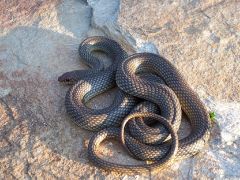Colubrid
| Colubrids
| ||||||||||||||||||||
|---|---|---|---|---|---|---|---|---|---|---|---|---|---|---|---|---|---|---|---|---|
 Caspian Whipsnake
Coluber (Dolichophis) caspius | ||||||||||||||||||||
| Scientific classification | ||||||||||||||||||||
| ||||||||||||||||||||
|
Boodontinae |
A colubrid (from Latin coluber, snake) is a snake that is a member of the Colubridae family. It is a broad classification of snakes that includes well over half of all snake species on earth. Colubrid species are found on every continent, except Antarctica[1].
A colubrid's body is almost completely covered in scales. They have highly flexible jaws, allowing them to consume large prey items, and have no remnant of a pelvic girdle[1].
While most colubrids are non-venomous (or have venom that isn't known to be harmful to humans) and are normally harmless, a few groups, such as genus Boiga, can produce medically significant bites, while the boomslang and the twig snakes have caused human fatalities. The venom is a modified form of saliva, secreted by glands in the upper jaw[1].
The venom-injecting fangs of colubrids are termed opisthoglyphous, meaning that the small, grooved fangs are located in the back of the upper jaw, unlike those of vipers and elapids, which are located in the front. Even non-venomous colubrids often have fangs in this position, and use them to puncture egg-shells or similar food[1].
Selected species
- Queen snake
- Grass snake
- King Snake
- Milk Snake
- Corn Snake
- Bull Snake
- Fox Snake
- Rat Snake
- Garter Snake
- Hognose Snake
- Indigo snake
- Smooth Snake
- Water Snake
- Mussurana
- House snake
Classification
The Colubrids are certainly not a natural group, as many are more closely related to other groups, such as elapids, than to each other. This family has classically been a dumping ground for snakes that don't fit anywhere else. There is on-going mitochondrial DNA research which may sort out the familial relations within this group[citation needed].
Subfamily Boodontinae
- Bothrolycus
- Bothrophthalmus
- Buhoma (tentatively placed here)
- Chamaelycus
- Dendrolycus
- Dipsina
- Dromophis
- Duberria (tentatively placed here)
- Gonionotophis
- Grayia
- Hormonotus
- Lamprophis
- Lycodonomorphus
- Lycophidion
- Macroprotodon
- Mehelya
- Montaspis (tentatively placed here)
- Pseudaspis
- Pseudoboodon
- Pythonodipsas
- Scaphiophis
Subfamily Calamariinae
- Calamaria
- Calamorhabdium
- Collorhabdium
- Etheridgeum
- Macrocalamus
- Pseudorabdion
- Rabdion
Subfamily Colubrinae - nearly 100 genera
Subfamily Dipsadinae
- Adelphicos
- Amastridium
- Atractus
- Calamodontophis (tentatively placed here)
- Carphophis (tentatively placed here)
- Chersodromus
- Coniophanes
- Contia (tentatively placed here)
- Crisantophis (tentatively placed here)
- Cryophis
- Diadophis (tentatively placed here)
- Diaphorolepsis (tentatively placed here)
- Dipsas
- Echinanthera (tentatively placed here)
- Emmochliophis (tentatively placed here)
- Enuliophis (tentatively placed here)
- Enulius (tentatively placed here)
- Eridiphas
- Geophis
- Gomesophis (tentatively placed here)
- Hydromorphus (tentatively placed here)
- Hypsiglena
- Imantodes
- Leptodeira
- Ninia
- Nothopsis (tentatively placed here)
- Pliocercus
- Pseudoleptodeira
- Pseudotomodon (tentatively placed here)
- Ptychophis (tentatively placed here)
- Rhadinaea
- Rhadinophanes (tentatively placed here)
- Sibon
- Sibynomorphus
- Synophis (tentatively placed here)
- Tachymenis (tentatively placed here)
- Taeniophallus (tentatively placed here)
- Tantalophis (tentatively placed here)
- Thamnodynastes (tentatively placed here)
- Tomodon (tentatively placed here)
- Tretanorhinus
- Trimetopon
- Tropidodipsas
- Urotheca
- Xenopholis (tentatively placed here)
Subfamily Homalopsinae - about 10 genera
Subfamily Natricinae - about 30 genera
Subfamily Pareatinae - 3 genera
Subfamily Psammophiinae
- Hemirhagerrhis
- Malpolon
- Mimophis
- Psammophis
- Psammophylax
- Rhamphiophis
Subfamily Pseudoxenodontinae
- Plagiopholis
- Pseudoxenodon
Subfamily Pseudoxyrhophiinae - about 20 genera
Subfamily Xenodermatinae
- Achalinus
- Fimbrios
- Oxyrhabdium
- Stoliczkaia
- Xenodermus
- Xylophis
Subfamily Xenodontinae - some 55-60 genera
incertae sedis
- Blythia
- Cercaspis
- Cyclocorus
- Elapoidis
- Gongylosoma
- Haplocercus
- Helophis
- Myersophis
- Omoadiphas (recently discovered)[citation needed]
- Oreocalamus
- Poecilopholis
- Rhabdops
- Tetralepis
- Thermophis
- Trachischium
ReferencesISBN links support NWE through referral fees
- ↑ 1.0 1.1 1.2 1.3 Bauer, Aaron M. (1998). in Cogger, H.G. & Zweifel, R.G.: Encyclopedia of Reptiles and Amphibians. San Diego: Academic Press, 188–195. ISBN 0-12-178560-2.
| |||||||||||
Credits
New World Encyclopedia writers and editors rewrote and completed the Wikipedia article in accordance with New World Encyclopedia standards. This article abides by terms of the Creative Commons CC-by-sa 3.0 License (CC-by-sa), which may be used and disseminated with proper attribution. Credit is due under the terms of this license that can reference both the New World Encyclopedia contributors and the selfless volunteer contributors of the Wikimedia Foundation. To cite this article click here for a list of acceptable citing formats.The history of earlier contributions by wikipedians is accessible to researchers here:
The history of this article since it was imported to New World Encyclopedia:
Note: Some restrictions may apply to use of individual images which are separately licensed.
